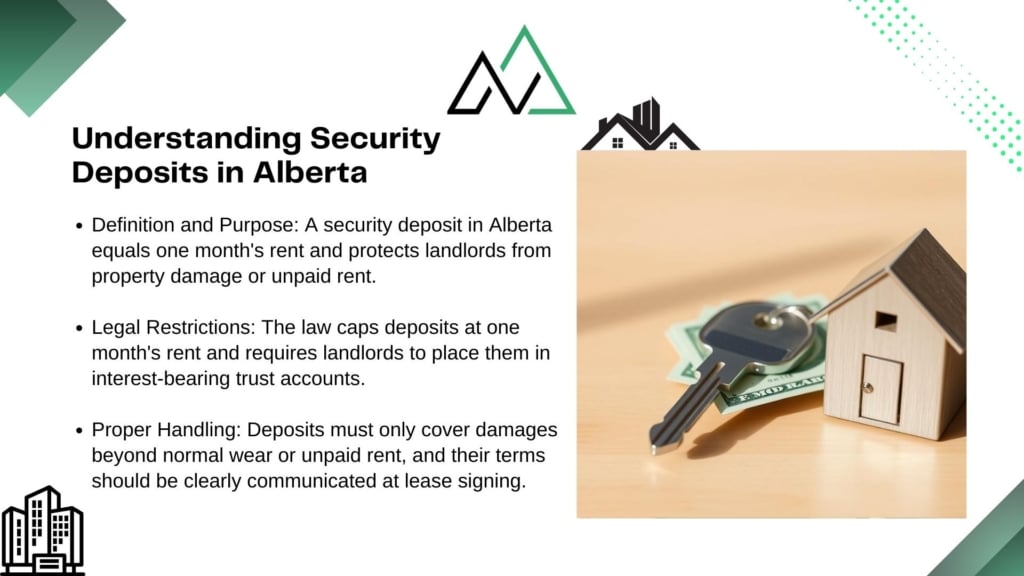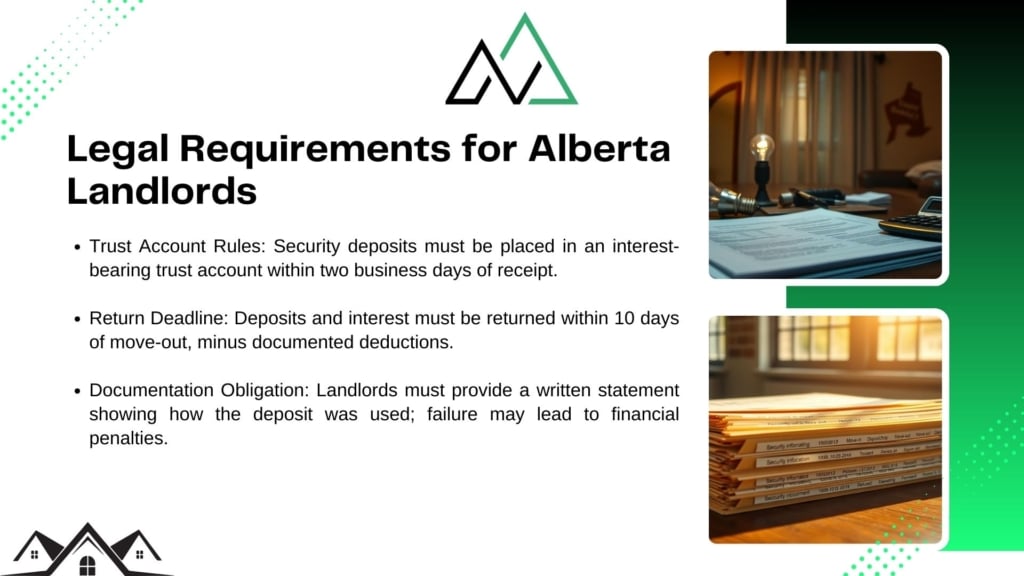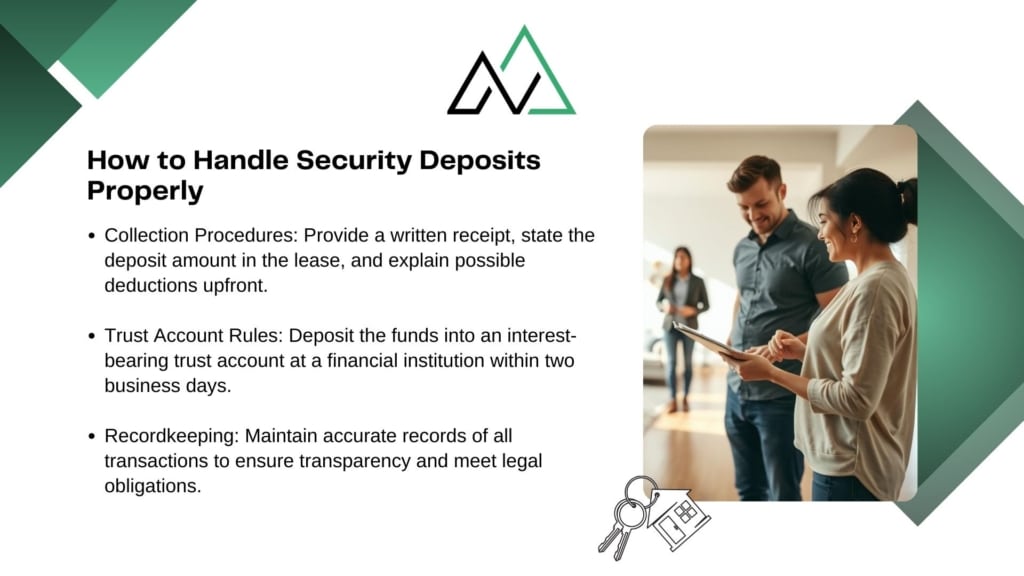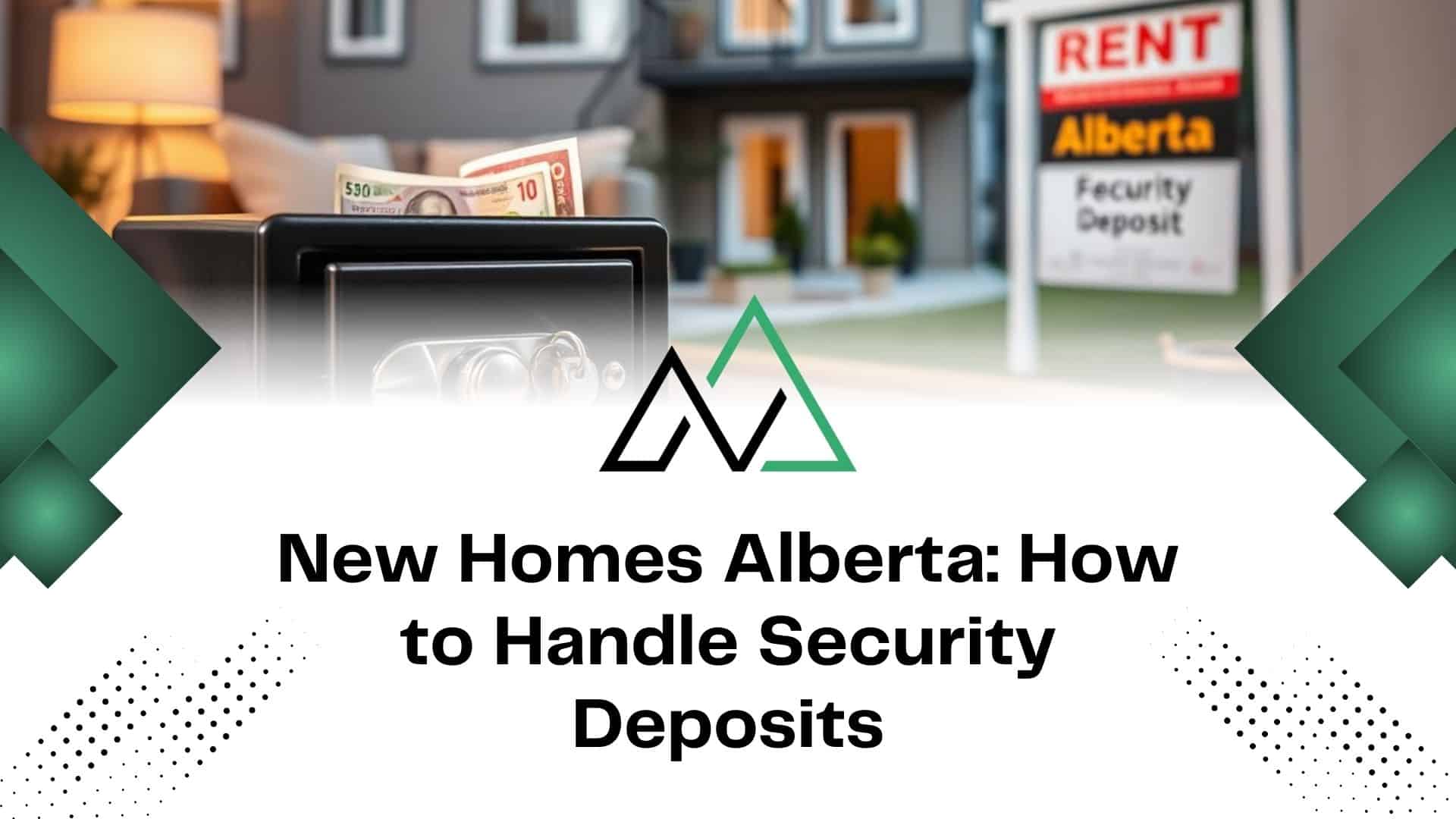In Alberta, a significant aspect of rental agreements is the security deposit, a monetary amount paid by tenants to landlords as insurance against potential damages. Notably, the security deposit is equivalent to one month’s rent at the start of a residential tenancy.
For landlords in Alberta, managing security deposits is crucial for protecting their investment properties. New Homes Alberta, with over a decade of experience in the real estate industry and accessible via (403)305-9167, guides you through the essential aspects of handling security deposits, ensuring compliance with Alberta’s regulations.
Key Takeaways
- Understand the legal framework governing security deposits in Alberta.
- Learn the proper procedures for collecting and returning security deposits.
- Discover the importance of documentation throughout the tenancy period.
- Address common challenges landlords face when handling security deposits.
- Gain insights into maintaining positive landlord-tenant relationships.
Understanding Security Deposits in Alberta

Understanding security deposits is essential for both landlords and tenants in Alberta, as they are a key component of rental agreements. A security deposit serves as a form of financial protection for landlords against potential property damage or unpaid rent when a tenant vacates the property.
What Is a Security Deposit?
A security deposit is a payment made by a tenant to a landlord at the start of a residential tenancy. In Alberta, this deposit is equivalent to one month’s rent. The primary purpose of the security deposit is to provide landlords with financial security in case the tenant causes damage to the property beyond normal wear and tear or fails to pay rent.
Legal Limits on Security Deposits in Alberta
Alberta law strictly regulates security deposits, limiting them to the equivalent of one month’s rent. Landlords are not permitted to request more than this amount, regardless of the property’s value or location. The security deposit must be placed in an interest-bearing trust account at a bank, treasury branch, credit union, or trust company. Here is a summary of the key points regarding security deposits in Alberta:
| Aspect | Details |
|---|---|
| Maximum Security Deposit | Equivalent to one month’s rent |
| Permitted Use | To cover damages beyond normal wear and tear or unpaid rent |
| Handling of Deposit | Must be placed in an interest-bearing trust account |
New Homes Alberta recommends that landlords clearly explain the purpose and conditions of the security deposit when establishing new rental agreements to prevent future misunderstandings.
Legal Requirements for Alberta Landlords

Landlords in Alberta need to be aware of the strict regulations governing security deposits. The province has established clear guidelines to ensure fair treatment of tenants and protect their deposits.
Provincial Regulations You Must Follow
Alberta’s Residential Tenancies Act sets out specific rules for handling security deposits. Landlords are required to deposit the security deposit into an interest-bearing trust account within two business days of receiving it from the tenant. This regulation ensures that the deposit earns interest over time. Additionally, landlords must provide a written statement of account when returning the security deposit, itemizing any deductions made.
- Landlords must comply with the Security Deposit Interest Rate Regulation, which is updated periodically.
- Any provision in a rental agreement that contradicts provincial law is automatically void.
Timeframes and Deadlines
Landlords in Alberta are required to return the security deposit within ten days after the tenant moves out, along with any accrued interest, minus legitimate deductions for damages or unpaid rent. Failure to comply with this timeframe can result in penalties, including potential orders to pay the tenant up to three times the security deposit amount.
To avoid disputes, landlords should maintain detailed records of the security deposit transaction, including the initial deposit and any subsequent deductions.
How to Handle Security Deposits Properly

Handling security deposits properly is crucial for landlords in Alberta to ensure compliance with provincial regulations. When a tenant pays a security deposit, it is typically equivalent to one month’s rent, a common practice in Alberta.
Collecting the Deposit
When collecting a security deposit, landlords should provide a written receipt to the tenant, clearly stating the amount received, the date of receipt, and the rental property’s address. The security deposit amount should be clearly outlined in the lease agreement to avoid any confusion. Landlords should also explain the conditions that might lead to deductions at the end of the tenancy, setting clear expectations from the beginning.
- Provide a written receipt for the security deposit.
- Clearly state the deposit amount in the lease agreement.
- Explain potential deductions to the tenant.
Banking Requirements
Alberta law requires landlords to deposit security deposits into a separate interest-bearing trust account within two business days of collection. This account should be established at a recognized financial institution, such as a bank or credit union, and should be dedicated specifically to security deposits.
| Banking Requirements | Description |
|---|---|
| Interest-Bearing Trust Account | Required for security deposits. |
| Timeframe for Deposit | Within two business days. |
| Financial Institution | Bank, credit union, or trust company. |
Maintaining detailed records of all security deposit transactions is essential, including deposit slips, account statements, and interest calculations throughout the tenancy period.
Move-In and Move-Out Inspections
Move-in and move-out inspections are vital for landlords to document property condition and avoid disputes. These inspections are crucial for managing security deposits effectively.
Conducting a Proper Move-In Inspection
During a move-in inspection, landlords should thoroughly document the condition of the property, including walls, floors, fixtures, appliances, and outdoor areas. This involves taking detailed notes and date-stamped photographs. Both the landlord and tenant should be present and sign the inspection report to acknowledge its accuracy. New Homes Alberta recommends using standardized inspection forms that comply with provincial requirements to ensure consistency.
Move-Out Inspection Best Practices
The move-out inspection should compare the property’s current condition to its condition at move-in, distinguishing between normal wear and tear and actual damage. Landlords must provide a clear list of damages and repair costs if they intend to deduct from the security deposit. If a tenant refuses to participate, landlords should document this refusal and complete the inspection with a witness.

Documentation and Record-Keeping
Effective documentation is crucial for landlords to manage security deposits properly. Proper record-keeping helps prevent disputes and ensures compliance with Alberta’s regulations.
Essential Documents to Maintain
Landlords should maintain several key documents related to security deposits. These include the signed lease agreement, security deposit receipt, move-in and move-out inspection reports, repair invoices, and any correspondence about the property’s condition. New Homes Alberta recommends keeping all security deposit-related documentation for at least three years after the tenancy ends.
- Signed lease agreement outlining security deposit terms
- Security deposit receipt
- Inspection reports
Digital vs. Physical Records
Landlords can choose between digital and physical record-keeping methods. Digital records offer easy searchability and backup capabilities, while physical records provide tangible evidence. Many landlords opt for a hybrid approach, maintaining both digital copies and original signed documents. Regardless of the method, consistency is key.

Legitimate Reasons for Security Deposit Deductions
When it comes to security deposits, landlords must understand what constitutes legitimate deductions. A security deposit can be kept if the damage is worse than normal wear and tear.
Normal Wear and Tear vs. Damage
Understanding the distinction between normal wear and tear versus actual damage is crucial. Normal wear and tear includes small problems like faded paint or worn carpet, which cannot be deducted from the security deposit. On the other hand, legitimate damage that warrants deductions includes large holes in walls, broken fixtures, and pet damage.
- Normal wear and tear includes faded paint, minor scuffs on walls, and worn carpet in high-traffic areas.
- Legitimate damage includes large holes in walls, broken fixtures, pet damage, and unauthorized alterations.
Unpaid Rent and Other Allowable Deductions
Unpaid rent is one of the most common reasons for security deposit deductions. If a tenant owes rent, the exact amount owed can be deducted from the deposit. Other allowable deductions include unpaid utility bills and costs for removing abandoned property.

- Unpaid rent and utility bills are common deductions.
- Landlords must provide itemized statements for all deductions, including copies of invoices or estimates for repairs.
New Homes Alberta emphasizes that all deductions must be reasonable and reflect actual costs.
Returning Security Deposits Correctly
Landlords in Alberta must adhere to strict guidelines when returning security deposits to ensure compliance with provincial law. This involves understanding the regulations surrounding the return process, including the calculation of interest and the timeframe for returning deposits.
Calculation of Interest
The interest on security deposits in Alberta is calculated from the day the landlord receives the deposit until the tenancy terminates or the deposit is returned, whichever comes first. The interest rate is determined annually by the Security Deposit Interest Rate Regulation. For instance, if a tenant paid a $1,000 security deposit for a year at a 1% interest rate, they would be owed $10 in interest, making their total return $1,010.
| Deposit Amount | Interest Rate | Interest Amount | Total Return |
|---|---|---|---|
| $1,000 | 1% | $10 | $1,010 |
The 10-Day Rule in Alberta
Alberta law mandates that landlords return security deposits within 10 days after a tenant moves out. If deductions are made, landlords must provide a written statement detailing these deductions within the same 10-day period. Using traceable methods like certified mail or electronic transfers can help document the return of the deposit.

Handling Security Deposit Disputes
Understanding the causes and resolution processes for security deposit disputes is crucial for landlords and tenants alike. Disagreements often arise over damages, unpaid rent, or cleaning costs, making it essential to know how to navigate these issues.
Causes of Disputes
Security deposit disputes often stem from differing interpretations of property condition or deduction justifications. Common causes include disagreements about normal wear versus damage, lack of proper documentation, and disputes over cleaning standards.Proper inspections and clear documentationcan mitigate these issues.
Dispute Resolution Process
In Alberta, the Residential Tenancy Dispute Resolution Service (RTDRS) provides a faster alternative to court for resolving security deposit disputes. Either party can file an application, which is typically resolved within 30-45 days. Documentation is critical during this process, including inspection reports and repair estimates.
| Dispute Cause | Resolution Method | Typical Resolution Time |
|---|---|---|
| Normal wear vs. damage | RTDRS | 30-45 days |
| Cleaning standards | RTDRS | 30-45 days |
| Unpaid rent | RTDRS or court | Varies |
For assistance with navigating security deposit disputes, landlords can contact New Homes Alberta at (403)305-9167 for expert guidance.

Conclusion
Proper handling of security deposits is essential for maintaining positive landlord-tenant relationships in Alberta. Throughout this guide, we’ve covered the critical aspects of security deposit handling, from collection and banking to inspections and documentation. By following Alberta’s regulations, landlords can avoid costly disputes and potential penalties. Remember, security deposits are capped at one month’s rent and must be returned within 10 days after tenancy ends. New Homes Alberta encourages landlords to view security deposit management as a professional responsibility. For expert guidance, contact New Homes Alberta at (403)305-9167. By implementing these best practices, landlords can create a fair and transparent system that protects their interests while respecting tenants’ rights.
FAQ
What is the maximum amount a landlord can charge for a security deposit in Alberta?
In Alberta, the security deposit is equivalent to one month’s rent. Landlords are not allowed to charge more than this amount.
How long does a landlord have to return a security deposit after a tenant moves out?
Landlords must return the security deposit within 10 days of the tenant moving out, provided there are no damages or unpaid rent.
What is considered normal wear and tear in a rental property?
Normal wear and tear refers to the expected deterioration of a property over time, such as faded paint or worn-out carpets. Landlords cannot deduct for normal wear and tear.
Can a landlord deduct from the security deposit for damages caused by previous tenants?
No, landlords can only deduct for damages caused by the current tenant. They are responsible for maintaining the property and addressing any existing damages.
What happens if a landlord and tenant disagree over the security deposit?
If a dispute arises, the parties can seek mediation or take the matter to the Residential Tenancy Dispute Resolution Service. A neutral third-party adjudicator will review the evidence and make a binding decision.
Are landlords required to pay interest on security deposits in Alberta?
Yes, landlords must pay interest on the security deposit at the end of each tenancy year, or when the deposit is returned, whichever comes first.
Can a security deposit be used to cover unpaid rent?
Yes, landlords can use the security deposit to cover unpaid rent, but they must provide an itemized list of deductions and return any remaining balance within the required timeframe.
What are the banking requirements for holding a security deposit in Alberta?
Landlords must hold the security deposit in a separate interest-bearing account at a bank or other financial institution in Alberta.





